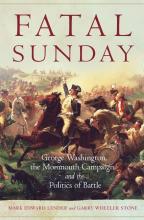Fatal Sunday: George Washington, the Monmouth Campaign, and the Politics of Battle
- By Mark Edward Lender and Garry Wheeler Stone
- University of Oklahoma Press
- 624 pp.
- Reviewed by James A. Percoco
- June 17, 2016
A fresh look at one of the most important fights of the American Revolution

One of the seminal lines from Fatal Sunday, Mark Edward Lender and Garry Wheeler Stone’s new examination of the battle of Monmouth, fought on June 28, 1778, encapsulates the whole premise of the book: “The Monmouth Campaign was the success [George] Washington needed to affirm his grip on the army and free himself from serious public criticism for the rest of the war. As a personal victory for the general, Monmouth was complete.”
Monmouth, the Continental Army’s attack on the British Army as it relocated from Philadelphia to New York City in the early summer of 1778, is one of the most difficult battles of the American Revolution to study and understand. The terrain affected troop movements on both sides and the ebb and flow of battlefield communications.
Most historians accept that the battle of Monmouth was a tactical draw. While Washington’s army held the field during the brutally hot and humid day, the British Army under command of General Henry Clinton was able to limp back into New York City badly battered but not beaten. For the authors, the real victor was George Washington. Written from a broad context, Fatal Sunday lets readers witness the behind-the-scenes guile and machinations which Washington endured from both critics inside his military family and members of Congress.
For much of the Revolution, Washington waged a two-front war, the conflict against his battlefield adversaries, the British, and against those who sought to undermine his control of the Continental Army from within. The authors contend that Washington needed a win in order to defeat his internal enemies, who might have marshaled the political strength to remove him from command. Given the internal acrimony in Congress and in the Continental Army, it’s a wonder that the United States secured eventual independence.
Lender and Stone adroitly weave the political tenor of the times together with the military situation in early 1778. Using sources found on both sides of the Atlantic, as well as recent archeological findings from the battlefield in New Jersey, the authors provide a compelling account of the men involved, the complicated troop movements of the battle, and a sterling summation of how Washington, through the work of his young supporters such as Alexander Hamilton, won the public-relations campaign after the battle that assured his control of the army.
Most accounts of the battle of Monmouth frame the action as the first significant battle the Continental Army fought toe-to-toe with the British Army after the winter encampment of Valley Forge. While Lender and Stone don’t deny the revitalizing role played by Prussian officer Baron Frederic von Steuben in reshaping the Continental Army, for them, that’s not the sole factor which led to military success on June 28, 1778. Rather, it was a combination of Washington’s leadership and a kind of “band of brothers” kinship that had developed among his troops.
As the British skulked across New Jersey, Washington very much wanted to attack elements of Clinton’s strung-out forces. He got his opportunity on Sunday, June 28, 1778. “The general had sought a limited engagement that would enhance his stature and pay political dividends; that is just what he got.”
Lender and Stone reconsider General Charles Lee, one of Washington’s sharpest critics and second-in-command of the Continental Army, who failed to follow orders to launch his attack when directed. Popular accounts would have us believe that Washington saved the day, arriving on the battlefield at a propitious moment. Lender and Stone offer an apology for Lee. Communication gaffes permeated the day’s fighting. Orders from all American parties were unclear and contradictory.
And the difficult terrain shaped the battle. To highlight this factor, the authors employ the words of Arthur Duke of Wellington, written generations later but so germane to warfare: “All the business of war, and indeed all the business of life, is to endeavor to find out what you don’t know by what you do; that’s what I called ‘guess what was at the other side of the hill.’”
Those interested in the American Revolution should read this book, but it’s not written for the novice. This is no fault of the authors, but rather the result of the fluid and complicated nature of this particular battle. Readers will find the narrative chock-full of anecdotes, grim battle scenes, and a cast of all-too-human characters on both sides who shaped the events of that fatal Sunday and of the war that carried on for another five years.
James A. Percoco is the Teacher-in-Residence for the Civil War Trust and the Journey Through Hallowed Ground Partnership and enjoyed a 32-year career as a high-school history teacher. He is a member of the National Teachers Hall of Fame.

